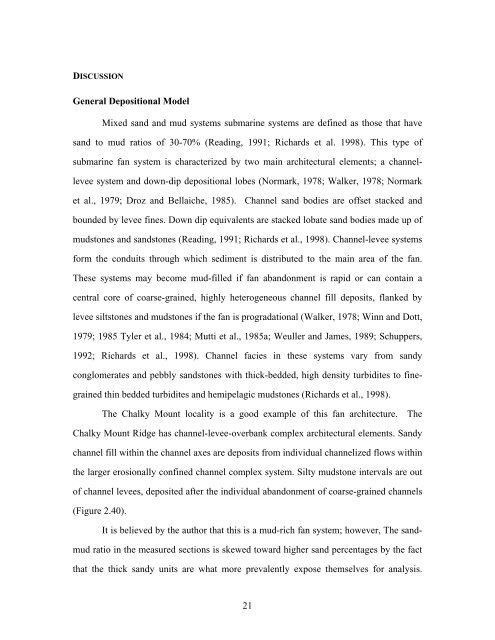Copyright by Nysha Chaderton 2009 - The University of Texas at ...
Copyright by Nysha Chaderton 2009 - The University of Texas at ...
Copyright by Nysha Chaderton 2009 - The University of Texas at ...
You also want an ePaper? Increase the reach of your titles
YUMPU automatically turns print PDFs into web optimized ePapers that Google loves.
DISCUSSION<br />
General Depositional Model<br />
Mixed sand and mud systems submarine systems are defined as those th<strong>at</strong> have<br />
sand to mud r<strong>at</strong>ios <strong>of</strong> 30-70% (Reading, 1991; Richards et al. 1998). This type <strong>of</strong><br />
submarine fan system is characterized <strong>by</strong> two main architectural elements; a channel-<br />
levee system and down-dip depositional lobes (Normark, 1978; Walker, 1978; Normark<br />
et al., 1979; Droz and Bellaiche, 1985). Channel sand bodies are <strong>of</strong>fset stacked and<br />
bounded <strong>by</strong> levee fines. Down dip equivalents are stacked lob<strong>at</strong>e sand bodies made up <strong>of</strong><br />
mudstones and sandstones (Reading, 1991; Richards et al., 1998). Channel-levee systems<br />
form the conduits through which sediment is distributed to the main area <strong>of</strong> the fan.<br />
<strong>The</strong>se systems may become mud-filled if fan abandonment is rapid or can contain a<br />
central core <strong>of</strong> coarse-grained, highly heterogeneous channel fill deposits, flanked <strong>by</strong><br />
levee siltstones and mudstones if the fan is prograd<strong>at</strong>ional (Walker, 1978; Winn and Dott,<br />
1979; 1985 Tyler et al., 1984; Mutti et al., 1985a; Weuller and James, 1989; Schuppers,<br />
1992; Richards et al., 1998). Channel facies in these systems vary from sandy<br />
conglomer<strong>at</strong>es and pebbly sandstones with thick-bedded, high density turbidites to fine-<br />
grained thin bedded turbidites and hemipelagic mudstones (Richards et al., 1998).<br />
<strong>The</strong> Chalky Mount locality is a good example <strong>of</strong> this fan architecture. <strong>The</strong><br />
Chalky Mount Ridge has channel-levee-overbank complex architectural elements. Sandy<br />
channel fill within the channel axes are deposits from individual channelized flows within<br />
the larger erosionally confined channel complex system. Silty mudstone intervals are out<br />
<strong>of</strong> channel levees, deposited after the individual abandonment <strong>of</strong> coarse-grained channels<br />
(Figure 2.40).<br />
It is believed <strong>by</strong> the author th<strong>at</strong> this is a mud-rich fan system; however, <strong>The</strong> sand-<br />
mud r<strong>at</strong>io in the measured sections is skewed toward higher sand percentages <strong>by</strong> the fact<br />
th<strong>at</strong> the thick sandy units are wh<strong>at</strong> more prevalently expose themselves for analysis.<br />
21
















